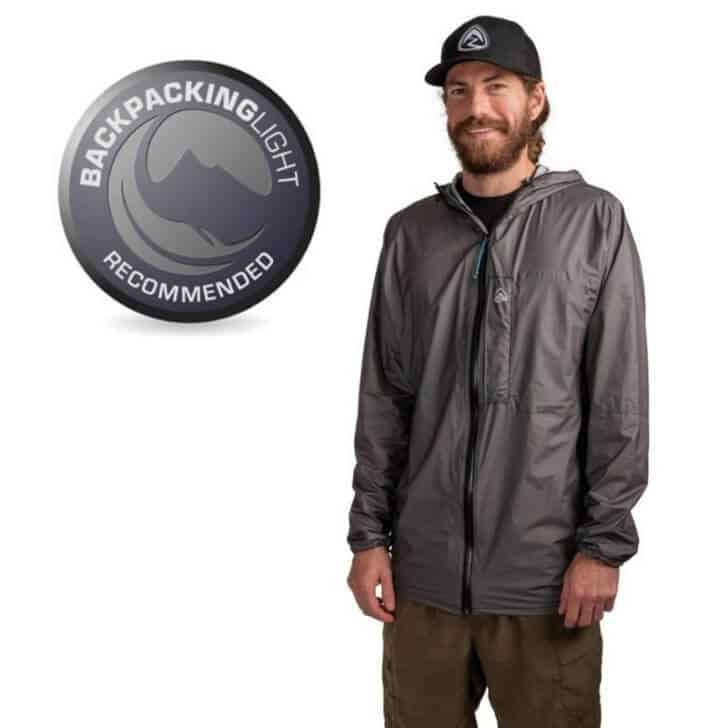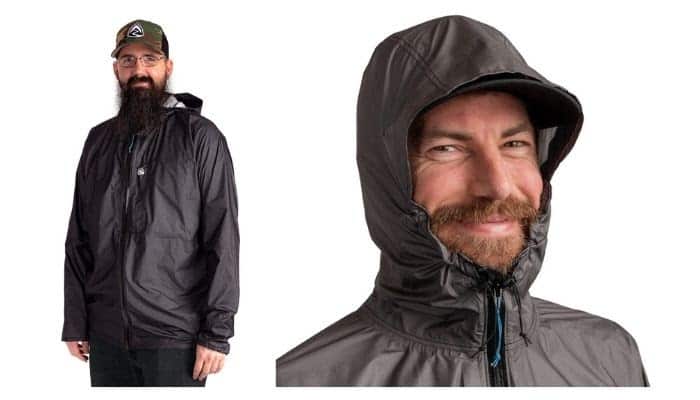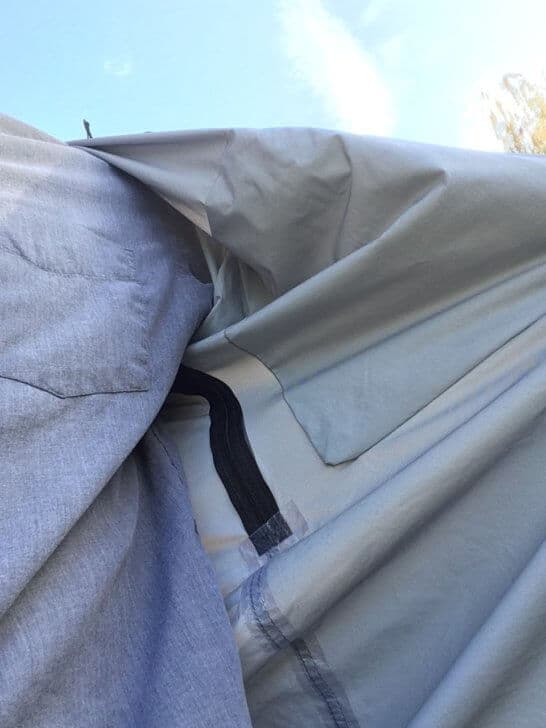SUMMARY
ZPacks Vertice Rain Jacket

The ZPacks Vertice Rain Jacket is a full-zip, waterproof-breathable, 3-layer hooded shell that weighs 5.6 oz (159 g). – $259 at ZPacks.
Highlights
- Lots of features for the weight, including pit zips
- Very high level of (claimed) breathability
- Fit issues in upper body may affect sizing for some users
- DWR lacks resiliency but can be refreshed with a better aftermarket solution
Introduction
The ZPacks Vertice Rain Jacket is a lightweight (5.6-5.9 oz / 158-166 g) full-zip hooded rain jacket made with an ultralight 3-layer fabric. It features a roll-away helmet-compatible hood, a chest pocket that doubles as self-storage, adjustable hood and cuffs, an elasticized hem, and waterproof chest and pit zippers. It’s available in a Women’s version.
This is a comprehensive, long-term review based on field testing performed by myself and Ryan Jordan in Idaho, Montana, California, and Wyoming during the summer, fall, and winter of 2019.

Features
- fully taped seams
- full-length waterproof front zipper
- waterproof pit zippers and chest pocket zipper
- elastic waist hem
- one-handed elastic shock cord tighteners at hood (aperture) and cuffs
- hood is helmet-compatible and includes a rear volume adjuster (strap and buckle)
- stiffened hood visor
- hood can be rolled away and secured with a buckle when not in use
- reversible chest pocket doubles as storage
- DWR treated face fabric
Specifications
All specifications here and elsewhere in the article are for a men’s size medium unless otherwise noted.
- weight (claimed): 5.6 oz (160 g)
- weight (measured): 5.9 oz (167 g)
- chest girth: 42 in (107 cm)
- waist hem girth: 42 in (107 cm)
- zipper length: 32 in (81 cm)
- sleeve length: 35 in (89 cm)
- chest pocket dimensions: 8 in x 9.5 in (20 cm x 24 cm)
Technology Summary
- Fabric: The ZPacks Vertice line uses three-layer waterproof breathable material that sandwiches its waterproof-breathable membrane between an outside face fabric of 7 denier ripstop nylon and a tricot inner lining. The fabric is treated with a C6 (fluorocarbon) finish for durable water repellency.
- fabric weight: 1.92 oz/yd2 (65 g/m2)
- vapor transfer (JIS L 1099 METHOD B1): 56,000+ g/m2/24hr
- water resistance: >20,000 mmH2O
- DWR treatment: C6
Pricing, Configurations, and Customization
- Options
- MSRP: $259
- Made in USA, fabric made in Japan

Description of Field Testing
I evaluated the performance of the ZPacks Vertice Rain Jacket based on the following criteria:
- Waterproofness – how well did the fabric, seams, and zippers resist water entry?
- Breathability – how well did the fabric breathe when using the jacket during high-exertion activity?
- Ventilation – how well did the jacket ventilate excess heat?
- Versatility – could the jacket do double duty as a wind shirt?
- Ease of use – how difficult were adjustment mechanisms to use, i.e., zippers, vents, drawcords, and hood?
- Quality of materials and manufacturing – what was the material quality, sewn seams, taping, etc.?
- Durability – how well did the jacket withstand high-abrasion areas (e.g., from pack straps) and how well did it survive bushwhacking?
- Fit – how did the jacket fit my body type? how was its range of motion?
- Packability – how is the jacket’s compressibility?
- Performance-to-Weight Ratio – how much performance does the jacket offer for its weight?
- Value – is the jacket a good value for its price?
Because the weather was so dry through August and into September when I started testing the ZPacks Vertice Rain Jacket, my initial field testing consisted of drenching myself at a water park and running 1.5 to 3 miles (1.6 to 4.8 km) through sprinkler systems at my local park. On these runs, I often wore a backpack weighing up to 13 lbs (5.9 kg) to simulate fastpacking. I also intentionally ran through dew-covered underbrush in the early mornings to test the fabric’s durability and water-shedding capabilities.
In mid-to-late September, I was able to expose the ZPacks Vertice to rain on backpacking trips in the Idaho Sawtooths and Caribou-Targhee National Forest. I hiked about 80 miles (129 km) with the ZPacks Vertice in a variety of fall weather conditions.
In addition to my first-hand experiences, I consulted with Backpacking Light Publisher Ryan Jordan, who used the jacket as a wind and snow shell during the sub-freezing days of winter in Wyoming, rainy fall bushwhacking in the Montana Beartooths, and summer talus scrambling in the High Sierra. Ryan and I co-wrote the commentary section at the end of this review.
When looking at a rain jacket for backpacking, I like to employ the principle of doing more with fewer items and less weight. This principle leads me to conclude that a good rain jacket should have more than just good precipitation resistance and breathability. I also want a rain jacket that takes up as little space as possible in my pack (because it gets used less often than I think), and I want it to function as a wind shirt in a pinch, so it should ventilate as much as possible.
Performance Assessment
Waterproofness
The most important feature of a rain jacket is how well it keeps you dry. Here are the features used in the ZPacks Vertice Rain Jacket that perform this function:
- The outer layer of the 3-layer fabric is the 7 denier ripstop nylon face fabric treated with a C6 durable water repellent finish. This helps water bead up on the face of the fabric. Water that doesn’t bead up (and wets out the fabric) slows vapor transmission which contributes to moisture buildup inside the jacket.
- The middle layer is a waterproof vapor-permeable layer that keeps liquid moisture from entering the inner layers of the jacket but allows for water vapor to be transferred from the inside to the outside.
- The inner layer is a tricot lining that serves to distribute liquid moisture (condensation or perspiration) into a larger surface area so that it evaporates through the vapor-permeable membrane at a higher rate.
- All seams are taped to prevent liquid moisture from entering through sewing holes.
- Waterproof zippers keep heavy rain from wicking through the zipper teeth and fabric.

Observations – waterproofness:
Member Exclusive
A Premium or Unlimited Membership* is required to view the rest of this article.
* A Basic Membership is required to view Member Q&A events



Home › Forums › ZPacks Vertice Rain Jacket Review